Maelstrom's Edge V2 - Unit Activation
Posted on Tuesday Sept 02, 2025 at 05:00pm in Gaming
One of the goals of the Maelstrom's Edge V2 rules is to give players some real tactical control over their units on the table, and one of the biggest changes was in the things a unit can do on the table. The V2 rules break a unit's activation into separate action categories, to give you more choices when it comes to choosing what to do with them each turn. We'll have a look at these different actions below.
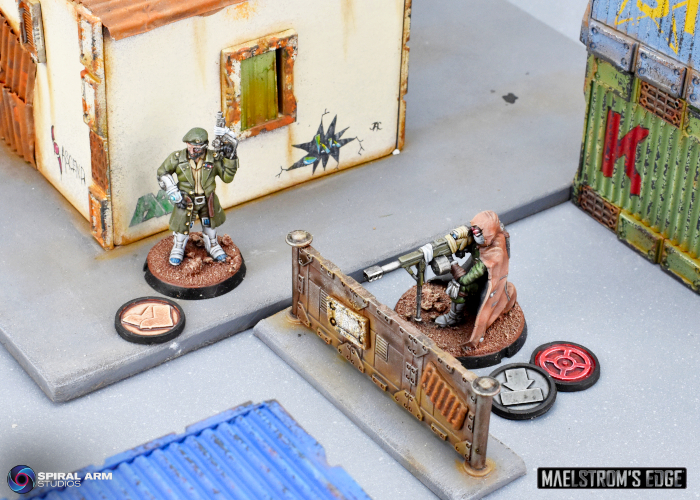
When a unit activates it can choose up to three actions from Movement, Status and Shooting categories. Some of these were already present in the V1 rules, but were a little more spread out and more difficult to keep track of. By consolidating and classifying the various actions, it's easier for players to remember what they can and can't do in a turn.
Movement actions dictate how fast the unit moves.
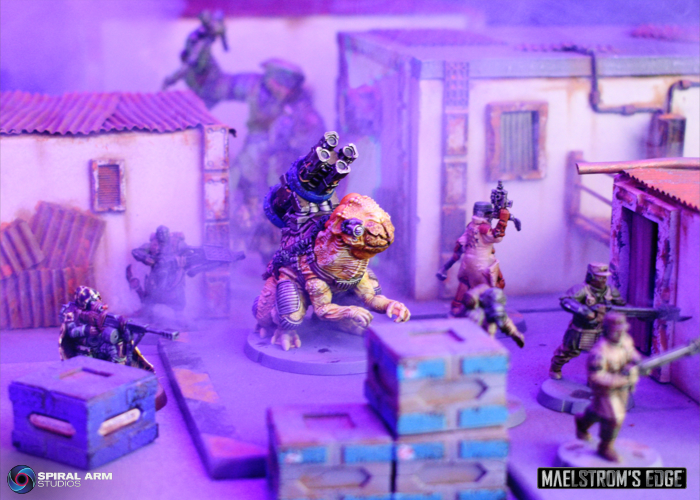
Status actions allow you to focus a unit towards specific goals.
Finally, Shooting actions cover the different options for attacking other units.
By selecting actions from each category in turn, a unit steps through its activation. For example, a unit can Move, then Take Aim in order to gain a boost to their shooting attacks, and then Fire on an enemy target.
While a unit can only select a single action each from Movement or Shooting, multiple Status actions can be combined so long as you stay within the maximum of three actions in total. So you could, for example, have a unit Take Cover and Aim, and then Fire upon enemy units from their more protected position.
To show how this all works, here's an Epirian SecDef Field Commander facing off against an Artarian Remnant Pathfinder. In the midst of battle, they have just caught sight of each other through the ...err ... trees? and shenanigans ensue.
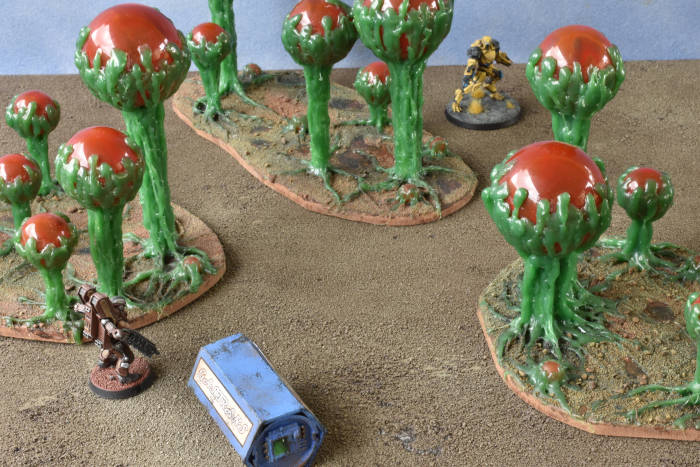
The Remnant player has Priority (meaning they activate a unit first this turn) and chooses to use a Move action to advance the Pathfinder through the trees to bring the Field Commander into short range (6"). They then use their Status action to Aim, applying a +2 bonus to the Pathfinder's SKL (Skill) stat.
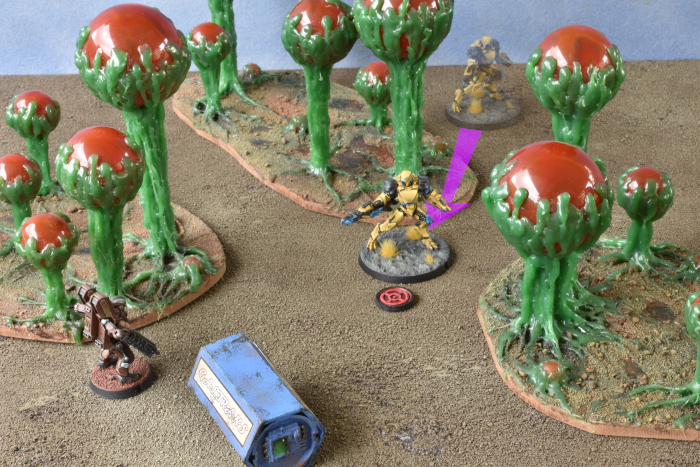
The Pathfinder's arc splitter has SHO 4, which means it normally rolls four dice to shoot, and as an SR (short ranged) weapon it receives an additional shot for being within 6" of the target. Rolling five dice, the Remnant player needs to equal or beat the Field Commander's EVS of 4. They roll two 1s, two 2s and a 4.
The Pathfinder has SKL 4, with the +2 from aiming increasing it to 6. This allows the Remnant player to adjust the rolls by up to 6 points in total. They flip the 2s up to 4s, but don't have enough points remaining to get either of the 1s up to a 4, so these remains missed shots.

The Epirian player now needs to roll to see if their armor blocks the three successful hits. They need to equal or beat the PEN (penetration) of the arc splitter, which is 3. Rolling three dice, they roll a 2, a 3 and a 4. The Field Commander's AV (Armor Value) of 4 allows them to flip the failing 2 up to a successful roll, which means all three shots are blocked.
While the Field Commander doesn't take any damage, being hit by enemy fire raises his Suppression Level, putting him on Level 1 (Marked in the picture below with the orange die).
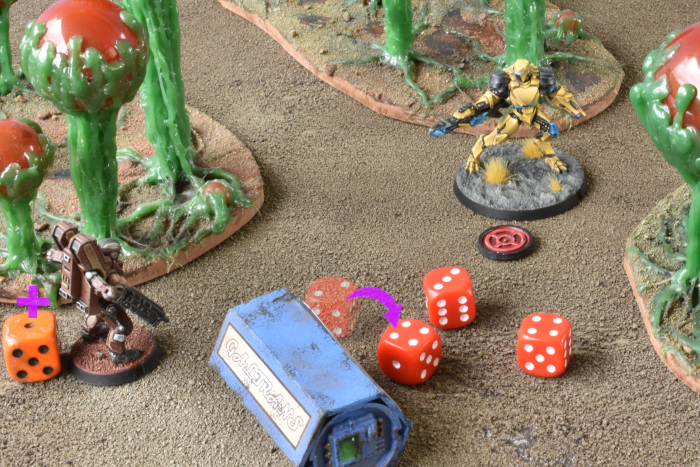
It's now the Epirian player's turn to activate a unit. They use a Move action to shuffle the Field Commander over behind the shipping crate, and a Take Cover action, which will give him some extra defense against any further enemy shooting until he activates next.
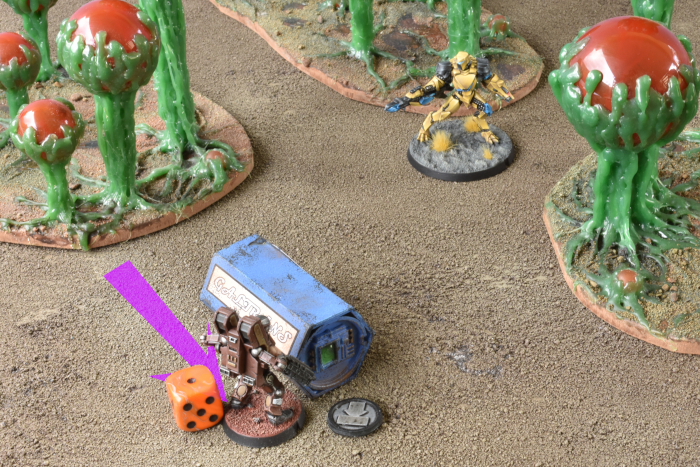
Regular models can normally only fire a single weapon per activation, but the Field Commander's Advanced Machine Assistance ability allows him to cut loose with all of his weapons at once. His two LM14 machine guns each have SHO 3, while his cluster missile launcher is an area of effect weapon, so has SHO 2 against the single model enemy unit. Grabbing two black dice for the missiles and six white dice for the machine guns, the Epirian player rolls five 2s, two 5s and a 6, needing to equal or exceed the Pathfinder's EVS of 4 to hit. The Field Commander has SKL 4 but is on Suppression Level 1, reducing his SKL by 1 point. The Epirian player chooses to use the remaining SKL 3 to flip the 3 and one of the 2s up to 4s.

Both Epirian weapons have the same PEN 4, but the 6 is a Critical Hit, requiring a roll of 6 to block. Rolling the dice from the successful hits, the Remnant player gets a 2, a 3, a 4 and a 5, and a 2 on the Critical hit. They use the Pathfinder's AV 4 to flip the regular 2 and the 3 up to 4s, but don't have enough points left to block the Critical Hit.
This means the Pathfinder suffers a single injury, which would be enough to kill a lesser warrior. Remnant Champions are made of tougher stuff though, capable of shrugging off significant damage, and even the comparatively light armored Pathfinder has a FOR (fortitude) of 5, meaning it needs to suffer 5 injuries to be removed as a casualty. It does however raise its Suppression Level by 2 (1 for the successful hits, and another because it suffered an injury).
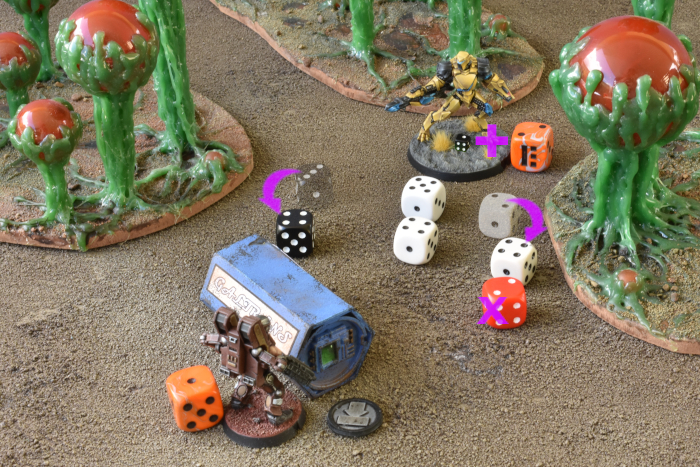
The final step in a model's activation is Recovery, allowing them to attempt to Shake Off suppression. The Epirian player rolls a D6, scoring a 4. This beats the Field Commander's WP of 3+, and so their suppression level is lowered by 1, back to 0. Play would then continue on to the next unit, if there is one, otherwise the players would move on to the next turn.
The Maelstrom's Edge V2 rulebook is now available! Grab your copy from the Maelstrom's Edge webstore now!
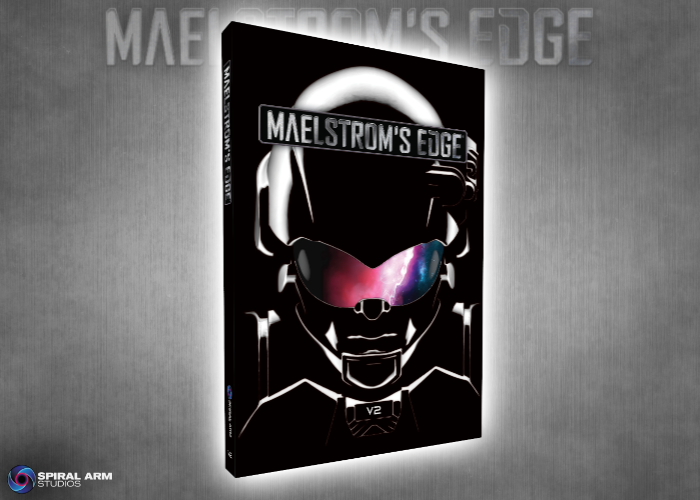
If you have any thoughts on the new rules, pop on over to the Comm Guild Facebook group, or start up a thread in the Maelstrom's Edge section on the Dakka Dakka forums. We welcome any feedback, and would love to hear how everyone's forces stack up in the new rules!

When a unit activates it can choose up to three actions from Movement, Status and Shooting categories. Some of these were already present in the V1 rules, but were a little more spread out and more difficult to keep track of. By consolidating and classifying the various actions, it's easier for players to remember what they can and can't do in a turn.
Movement actions dictate how fast the unit moves.
MOVEMENT ACTIONS
- MOVE: The unit moves up to its MV characteristic in inches.
- DASH: The unit moves up to double its MV characteristic in inches, but at the cost of degrading the accuracy of any shooting action it performs.
- CHARGE: The unit moves up to double its MV characteristic in inches, but must move into contact with an enemy unit, who then gets to perform Defensive Fire against the charging unit.

Status actions allow you to focus a unit towards specific goals.
STATUS ACTIONS
- ON THE MOVE: A unit on the move immediately gets to make bonus movement. In addition, a unit that is on the move is both less accurate when shooting and harder to hit when being fired upon.
- TAKE COVER: A unit taking cover gains protection from the terrain it is touching when the enemy shoots at it, and even gets a small amount of protection if it is in open ground. A unit which is taking cover cannot also be on the move, and vice versa.
- AIM: A unit that aims is more accurate when shooting during its activation.
Finally, Shooting actions cover the different options for attacking other units.
SHOOTING ACTIONS
- FIRE: The unit fires a standard round of shooting, which can cause both damage and suppression on the target.
- SUPPRESSIVE FIRE: A special round of shooting, which utilizes a weapon’s Suppression characteristic. No damage can be inflicted, but more suppression can be caused than with a standard round of shooting.
- CQ FIGHTING: A special attack against enemies in base contact with the firing unit, using melee weapons or pistols.
By selecting actions from each category in turn, a unit steps through its activation. For example, a unit can Move, then Take Aim in order to gain a boost to their shooting attacks, and then Fire on an enemy target.
While a unit can only select a single action each from Movement or Shooting, multiple Status actions can be combined so long as you stay within the maximum of three actions in total. So you could, for example, have a unit Take Cover and Aim, and then Fire upon enemy units from their more protected position.
To show how this all works, here's an Epirian SecDef Field Commander facing off against an Artarian Remnant Pathfinder. In the midst of battle, they have just caught sight of each other through the ...err ... trees? and shenanigans ensue.

The Remnant player has Priority (meaning they activate a unit first this turn) and chooses to use a Move action to advance the Pathfinder through the trees to bring the Field Commander into short range (6"). They then use their Status action to Aim, applying a +2 bonus to the Pathfinder's SKL (Skill) stat.

The Pathfinder's arc splitter has SHO 4, which means it normally rolls four dice to shoot, and as an SR (short ranged) weapon it receives an additional shot for being within 6" of the target. Rolling five dice, the Remnant player needs to equal or beat the Field Commander's EVS of 4. They roll two 1s, two 2s and a 4.
The Pathfinder has SKL 4, with the +2 from aiming increasing it to 6. This allows the Remnant player to adjust the rolls by up to 6 points in total. They flip the 2s up to 4s, but don't have enough points remaining to get either of the 1s up to a 4, so these remains missed shots.

The Epirian player now needs to roll to see if their armor blocks the three successful hits. They need to equal or beat the PEN (penetration) of the arc splitter, which is 3. Rolling three dice, they roll a 2, a 3 and a 4. The Field Commander's AV (Armor Value) of 4 allows them to flip the failing 2 up to a successful roll, which means all three shots are blocked.
While the Field Commander doesn't take any damage, being hit by enemy fire raises his Suppression Level, putting him on Level 1 (Marked in the picture below with the orange die).

It's now the Epirian player's turn to activate a unit. They use a Move action to shuffle the Field Commander over behind the shipping crate, and a Take Cover action, which will give him some extra defense against any further enemy shooting until he activates next.

Regular models can normally only fire a single weapon per activation, but the Field Commander's Advanced Machine Assistance ability allows him to cut loose with all of his weapons at once. His two LM14 machine guns each have SHO 3, while his cluster missile launcher is an area of effect weapon, so has SHO 2 against the single model enemy unit. Grabbing two black dice for the missiles and six white dice for the machine guns, the Epirian player rolls five 2s, two 5s and a 6, needing to equal or exceed the Pathfinder's EVS of 4 to hit. The Field Commander has SKL 4 but is on Suppression Level 1, reducing his SKL by 1 point. The Epirian player chooses to use the remaining SKL 3 to flip the 3 and one of the 2s up to 4s.

Both Epirian weapons have the same PEN 4, but the 6 is a Critical Hit, requiring a roll of 6 to block. Rolling the dice from the successful hits, the Remnant player gets a 2, a 3, a 4 and a 5, and a 2 on the Critical hit. They use the Pathfinder's AV 4 to flip the regular 2 and the 3 up to 4s, but don't have enough points left to block the Critical Hit.
This means the Pathfinder suffers a single injury, which would be enough to kill a lesser warrior. Remnant Champions are made of tougher stuff though, capable of shrugging off significant damage, and even the comparatively light armored Pathfinder has a FOR (fortitude) of 5, meaning it needs to suffer 5 injuries to be removed as a casualty. It does however raise its Suppression Level by 2 (1 for the successful hits, and another because it suffered an injury).

The final step in a model's activation is Recovery, allowing them to attempt to Shake Off suppression. The Epirian player rolls a D6, scoring a 4. This beats the Field Commander's WP of 3+, and so their suppression level is lowered by 1, back to 0. Play would then continue on to the next unit, if there is one, otherwise the players would move on to the next turn.
The Maelstrom's Edge V2 rulebook is now available! Grab your copy from the Maelstrom's Edge webstore now!

If you have any thoughts on the new rules, pop on over to the Comm Guild Facebook group, or start up a thread in the Maelstrom's Edge section on the Dakka Dakka forums. We welcome any feedback, and would love to hear how everyone's forces stack up in the new rules!
Like this? Like us on facebook to see more...
